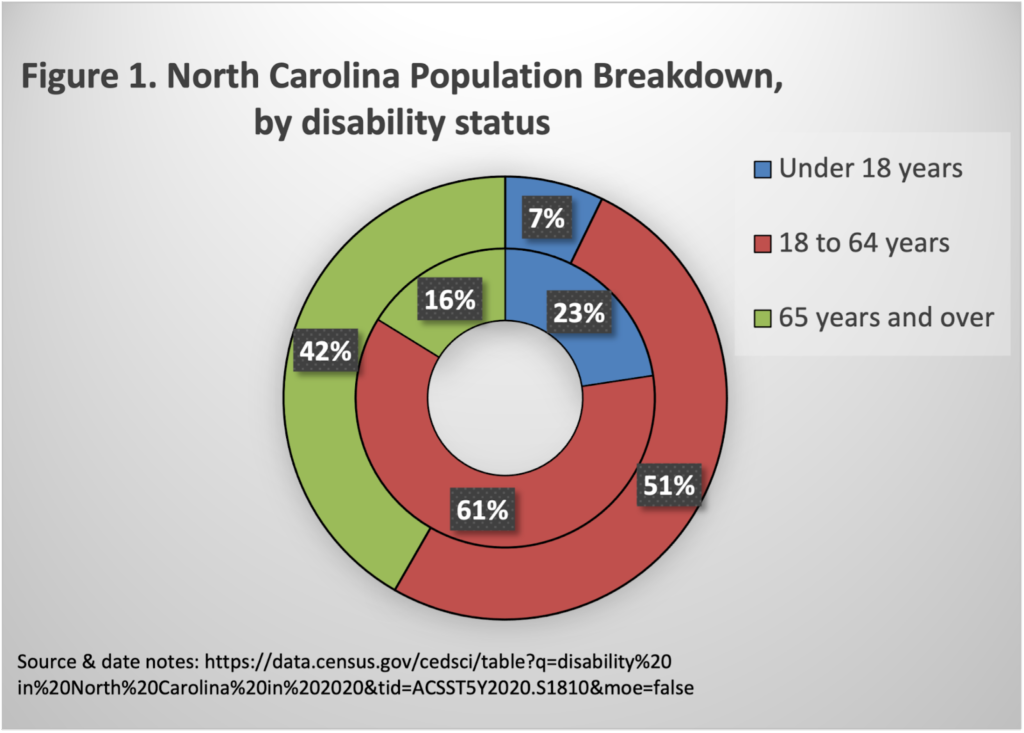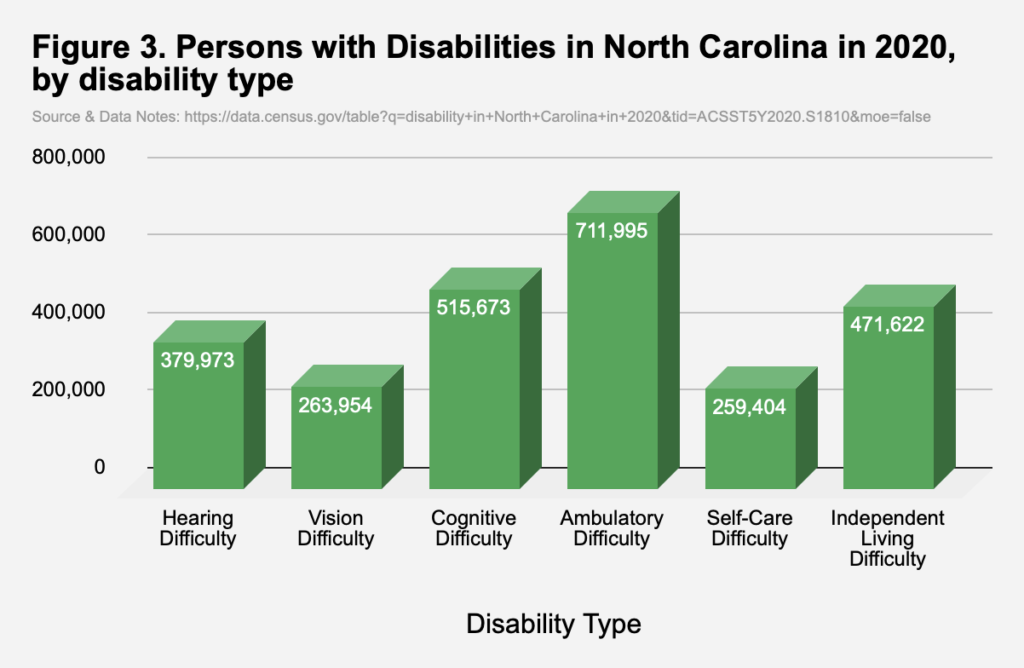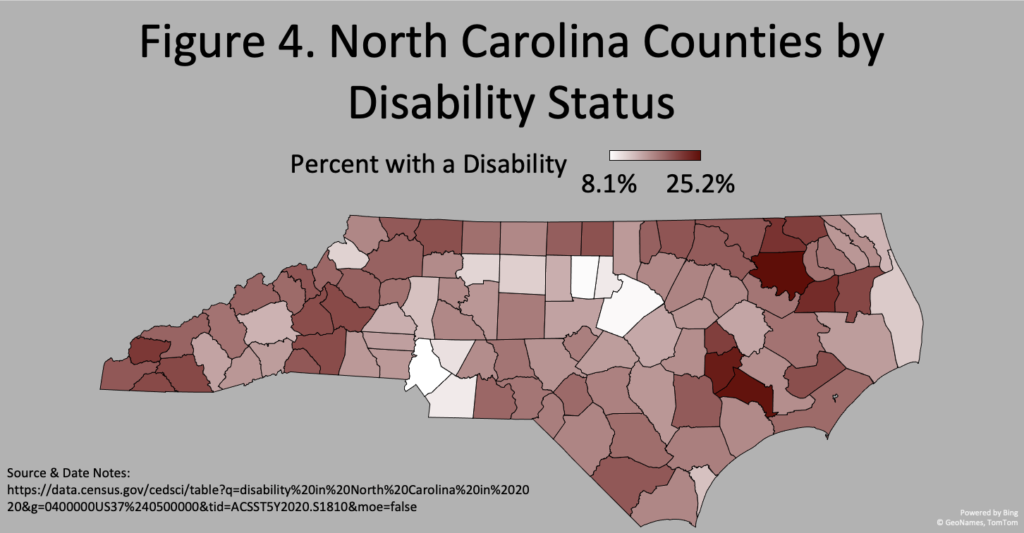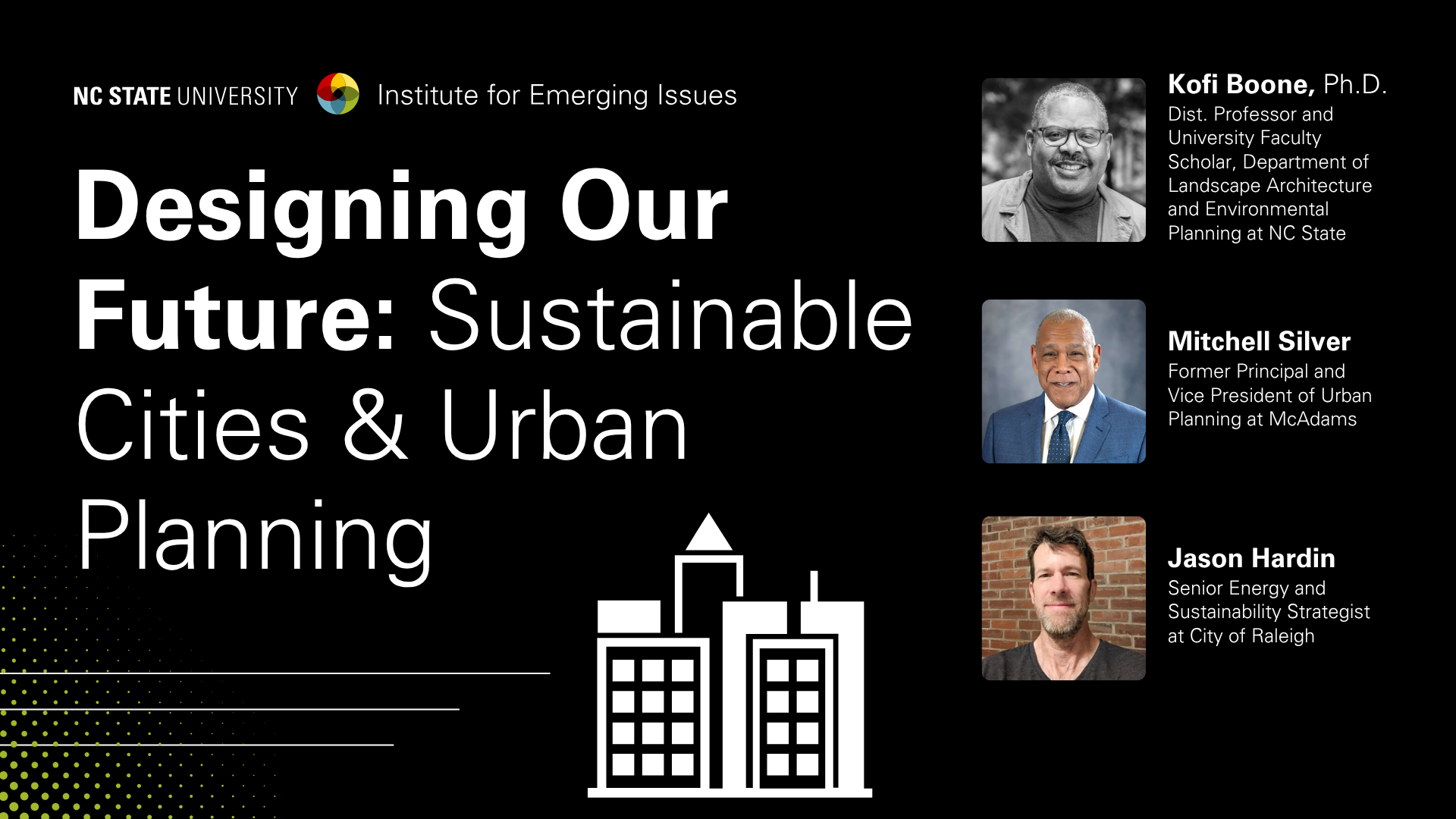The Employment of Persons with a Disability and/or Neurodiversity
Data Brief by Brodie Smith, IEI Policy Intern
Completed 11/17/2022
Who are Persons with a Disability or Neurodiversity?
Contrary to popular belief, neurodiversity is not the same thing as disability. The Americans with Disabilities Act defines the term “disability” as “a physical or mental impairment that substantially limits one or more major life activities of such individual; a record of such an impairment; or being regarded as having such an impairment.” There are also multiple types of disabilities with their definitions as follows:
| Hearing Difficulty | Being deaf or having serious difficulty hearing |
| Vision Difficulty | Being blind or having serious difficulty seeing, even when wearing glasses |
| Cognitive Difficulty | Due to a physical, mental or emotional problem, having difficulty remembering, concentrating or making decisions |
| Ambulatory Difficulty | Having serious difficulty walking or climbing stairs |
| Self-Care Difficulty | Having difficulty bathing or dressing |
| Independent Living Difficulty | Because of a physical, mental or emotional problem, having difficulty doing errands alone such as visiting a doctor’s office or shopping |
As multiple points of data in this document come from the American Community Survey, the list of six questions used to determine whether an individual has a disability are provided below as a reference. These six questions are as follows:
- Is this person deaf or does he/she have serious difficulty hearing?
- Is this person blind or does he/she have serious difficulty seeing even when wearing glasses?
- Because of a physical, mental or emotional condition, does this person have serious difficulty concentrating, remembering or making decisions?
- Does this person have serious difficulty walking or climbing stairs?
- Does this person have difficulty dressing or bathing?
- Because of a physical, mental or emotional condition, does this person have difficulty doing errands alone such as visiting a doctor’s office or shopping?
In this report, we will use phrases such as “individuals with disabilities” or “person with a disability,” but there are multiple ways in which you can refer to someone who has a disability, with everyone having their own preference on how they are referred to. Learn more about inclusive language for people with disabilities here.
Neurodiversity describes the idea that people experience and interact with the world differently, and that there is no “correct” way of behaving or thinking. Neurodiversity encapsulates a broad range of conditions such as autism spectrum disorder (ASD), attention-deficit hyperactivity disorder (ADHD), generalized anxiety disorder (GAD) and many others. While some neurodiverse conditions fall under the umbrella of “disability,” not all neurodiverse people qualify as having a disability under the Americans with Disabilities Act; however, some may need accommodations at work or school in order to be successful.
Highlights
- In 2020, approximately 40.8 million people (about 1 in every 8) in the United States identified as having one or more disabilities.
- In 2020, roughly 1,363,000 people in North Carolina (13.4%) identified as having one or more disabilities.
- Individuals ages 65 and older account for about 16.2% of the statewide population, however they make up 41.7% of the population of persons with disabilities in North Carolina in 2020.
- In 2020, the three North Carolina counties with the highest percentages of persons with disabilities were Bertie County (25.2%), Jones County (24.8%) and Lenoir County (24%), all rural counties in Eastern NC.
- In 2021, the unemployment rate for persons with disabilities ages 16 and older was 10.1%, nearly double that of the general population (5.3%).
- In July 2021, 43.7% of persons with a disability in the United States who were not working reported some type of barrier to employment. Some of the most common barriers reported were their own disability, lack of proper training and the need for special accommodations at the place of work.
National Data on Persons with a Disability or Neurodiversity
In 2020, approximately 40.8 million people (12.7%) in the United States civilian noninstitutionalized population identified as having one or more disabilities. That is 1 in every 8 people. This population of people with disabilities varies across sex, race, and ethnicity. If we break that group down by their sex, males accounted for 48.3% (about 19.7 million), and females accounted for 51.7% (about 21.1 million). When you compare different racial and ethnic groups within this population, you see that the group with the highest rate of having a disability is Native American and Alaska Native people at 16.9%, followed by Black people at 14%, White people at 13.3%, Native Hawaiian and Other Pacific Islanders at 11.3%, Hispanic or Latino people of any race at 9.2%, and Asian people at 7.2%.
While there is no data on how many people in the United States identify as neurodiverse, a 2020 study estimated that 15-20% of the population worldwide is neurodiverse.
North Carolina Data on Persons with a Disability or Neurodiversity
As of 2020, roughly 1,363,000 North Carolinians (13.4%) identified as having one or more disabilities, or more than 1 in every 8 people in the civilian noninstitutionalized population. These rates also vary across sex, race, ethnicity, age and annual earnings.
In 2020, about 710,800 females had one or more disabilities (52.1%) compared to 652,300 males (47.9%). Native Americans and Alaska Natives had the highest rates of disability at 18.3%. They are followed by Black individuals at 14.4%, White individuals at 13.8%, Hispanic and Latino individuals at 6.6%, and finally Asian individuals at 5.3%.
If we look at this population breakdown by age, we see that about 695,400 people (11.2%) ages 18 to 64 identify themselves as having a disability, which represents 1 in 9 people in that age category. For individuals ages 65 and up, 568,100 people (34.5%) identify themselves as having one or more disabilities. Individuals ages 65 and older make up 16.2% of the statewide population but account for 41.7% of the disabled population in North Carolina. On the other hand, individuals ages 18 to 64 make up 61.2% of the statewide population but account for 51.1% of the population with disabilities. To further examine the population breakdown for persons with disabilities compared to the statewide population, refer to Figure 1, with data coming from the American Community Survey (ACS). The inner ring depicts the breakdown of the North Carolina statewide population, while the outer ring depicts the North Carolina population with a disability.

Looking at the annual earnings of individuals with disabilities, we see that in North Carolina people who have one or more disabilities typically earn less than those with no disabilities. In 2020, those with a disability had a median annual earnings of $23,072, which is significantly lower than the median annual earnings of those without a disability at $34,200. To put this in perspective, people with a disability made about $0.67 for every $1.00 made for people with no disabilities. To break up the annual earnings even further, we see that 52.2% of people with disabilities brought in an annual income of $24,999 or less, meanwhile 36.6% of those with no disabilities fell into that same bracket. View Figure 2 for a detailed breakdown of annual earnings for both individuals with and without a disability.

Persons with disabilities in North Carolina vary across sex, race, ethnicity, age and annual earnings, but they also vary in type of disability. There is a broad range when it comes to different disability types, and the American Community Survey summarized this spectrum with six overarching categories: hearing difficulty, vision difficulty, cognitive difficulty, ambulatory difficulty, self-care difficulty and independent living difficulty. In North Carolina, the disability type most prevalent is ambulatory difficulty with 711,995 individuals. View Figure 3 to see how the various types of disabilities are represented in North Carolina.

County Data on Persons with a Disability or Neurodiversity
Across North Carolina’s 100 counties, the percent of persons with a disability varies greatly. In 2020, the top ten North Carolina counties with the highest percentages of persons with disabilities were Bertie County (25.2%), Jones County (24.8%), Lenoir County (24%), Washington County (22.7%), Hertford County (22.1%), Graham County (21.8%), Gates County (21.4%), Greene County (21.3%), Tyrrell County (20.7%) and Macon County (20.6%). In total, there are 17 counties in North Carolina with a percent of persons with disabilities equal to or greater than 20%. Figure 4 shows the percent with a disability in each of North Carolina’s counties, ranging from 8.1% (Mecklenburg County) to 25.2% (Bertie County).

Of North Carolina’s 100 counties, there are 78 counties that are considered to be rural counties according to the NC Rural Center. The remaining 22 counties that are considered to be non-rural, which are described as suburban and urban counties. Rural counties in North Carolina have drastically higher percentages of persons with disabilities compared to their non-rural counterparts. The top half (50 counties) of North Carolina counties with the highest percentages of persons with disabilities were all rural counties, meanwhile the top 20 counties with the lowest percentages of persons with disabilities contained only five rural counties with 15 non-rural counties.
Employment Data
Now that we know how persons with a disability or neurodiversity account for the population on local and national levels, let’s explore the employment data of the same demographic groups. According to a report put forth by the Bureau of Labor Statistics in 2021, the national unemployment rate for persons with a disability ages 16 and older was 10.1%, and equated to approximately 669,000 individuals with a disability facing unemployment. This unemployment rate was nearly twice as much as the rate for the general population ages 16 and older (5.3%). In this report the employment data is broken down by sex, age, race and ethnicity and is further detailed below.
Unlike the general population in 2021, there was no significant difference between the unemployment rate for men and women who had a disability, with both groups coming in at 10.1%. However when you break this group up by race and ethnicity, you see that there are great inequalities between the different groups. Of all persons with a disability, the group with the highest unemployment rate was Black individuals at 15.1%. They were followed by Hispanic or Latino individuals at 13.3%, White individuals at 9.3%, and the group with the lowest unemployment rate was Asian individuals at 8.5%. (The BLS report did not include any data on Native American peoples due to the small sample sizes for their population.) To look at persons with a disability by their age, approximately half of the entire population were ages 65 and over, compared with 18% of those with no disability. For individuals ages 16 to 64, the unemployment rate was 10.8%, with about 591,000 people facing unemployment. People ages 65 and over had an unemployment rate of 6.8%, representing 78,000 individuals. While individuals ages 16 to 64 accounted for about half of the entire population with a disability, they made up 88.3% of the unemployed population of those with a disability.
While there is limited data on the employment of individuals with neurodiversity, it is estimated that the unemployment rate for individuals with Autism Spectrum Disorder is 86%, with 77% of unemployed neurodiverse individuals reporting that they are open and willing to work.
Barriers to Employment
Barriers to employment for persons with a disability are oftentimes more personal or related to the environment of the job itself. These barriers and obstacles can range from physical to social. The World Health Organization (WHO) defines employment barriers as “factors that limit functioning through their presence or absence,” and include, but are not limited to: a physical environment that is inaccessible or difficult to navigate, a lack of assistive tools to help the person work effectively, negative attitudes within the workplace and a lack of relevant systems, services and policies.
In a report from the Bureau of Labor Statistics regarding barriers to employment for persons with a disability, in July 2021, 43.7% of persons with a disability who were not working reported some type of barrier to employment. When asked to identify the barriers they had encountered, most of those ages 16 to 64 reported that their own disability acted as a barrier to employment (81.5%). Other barriers reported included the lack of education or training (13.1%), the need for special features at the job (12.5%), the lack of transportation (11.6%), employer or coworker attitudes (10.4%), the lack of job counseling (6.3%) and the loss of government assistance (4.9%). Also in this report was information on those who requested a change in their current workplace to better accommodate their disability, with 15.6% of those ages 16 to 64 with a disability requesting a change. Some of these changes included new or modified equipment, physical changes to the workplace, updated workplace policies and a change in their work schedule.
Policies and Programs Surrounding Persons with a Disability or Neurodiversity
There are numerous policies and programs in place across the country, as well as the local level here in North Carolina, that are geared towards protecting the rights of persons with disabilities, including their rights surrounding employment. To read more about some of the federal and state laws and programs for persons with disabilities, check them out below:
The Americans with Disabilities Act (ADA) of 1990
This piece of federal legislation, specifically Title I, protects the employment rights of people with disabilities who work for employers with 15 or more employees. The main purpose of this policy is to help persons with disabilities access the same employment opportunities and benefits available to people without disabilities. This legislation also requires employers to provide reasonable accommodations to individuals with disabilities, as well as setting up a federal definition for what a disability is.
The North Carolina Persons with Disabilities Protection Act
This act is intended to promote equality of opportunity for persons with disabilities and help them achieve economic self-sufficiency. This legislation addresses discrimination in public accommodations, public service, transportation and employment, with most of its protections relating back to employment matters. If an individual with a disability is a “qualified” person, then this act provides protections such as the requirement for reasonable accommodations in the workplace and the prohibition of failing to hire, promote or discharge an individual on the basis of their disability.
The Family and Medical Leave Act (FMLA)
The FMLA entitles eligible employees of covered employers to take job-protected, unpaid leave for family and medical reasons. This allows those who may need to take time off for certain medical procedures or for family care, and then return back to work once the leave has ended. This act would allow easier access to medical leave for a person with a disability or a family leave for a relative who cares for a person with a disability.
If you would like to learn more about employment rights for people with disabilities, check out the website below from the U.S. Department of Labor’s Office of Disability Employment Policy.
There are also various programs and resources in North Carolina available for people with disabilities. These resources are intended to help create more equitable employment opportunities for persons with disabilities in North Carolina. A few of these programs are:
Everybody Works NC, North Carolina Council on Developmental Disabilities
The Everybody Works NC campaign was launched in order to increase awareness of the talent found in the North Carolina disability community and to create more jobs and job-oriented educational opportunities. The campaign has three main components: educating employers who are looking to hire persons with disabilities, helping persons with disabilities who are looking for employment and informing the public on how they can participate to promote job opportunities for persons with disabilities.
North Carolina Vocational Rehabilitation
The VR program helps individuals with disabilities achieve their employment goals through counseling, education and training programs, job placement assistance, assistive technology and many other services. This state program is designed to help persons with disabilities find, get or keep a job and is free for those who are eligible.
Linking North Carolina with Innovative Talent (LiNC-IT)
This initiative launched in 2018 under the North Carolina Business Committee for Education (NCBCE) and is committed to providing internship opportunities for neurodivergent youth in North Carolina. By leveraging existing employer relations and state resources, LiNC-IT is able to connect these students and young people with Autism Spectrum Disorder (ASD) with employment experience through paid internships with various employer partnerships. This initiative also supports employers by collaborating with them to design a program that meets their organizational needs while also creating a workspace that allows the interns to be successful in their roles.
Success in Action
Disability:IN North Carolina (DI-NC) is an organization dedicated to collaborating to promote the full inclusion of people with disabilities, to inspire accessible innovation and foster cultures of inclusion. To do this, they work to educate, train, consult and support persons with disabilities while connecting them to partner organizations and agencies to place them in fulfilling jobs. DI-NC also works with high school and college-aged students for mentoring and consulting programs to prepare them for employment opportunities at an earlier age.
Think College works to provide resources, technical assistance and proper training related to college options for students with intellectual disabilities in the United States. Think College, which is based out of the Institute for Community Inclusion at UMass Boston, supports evidence-based and student-centered research and practice through the generation and sharing of knowledge, guiding institutional change, informing those who work with public policy and ultimately, engaging with students, professionals and families. Through various projects relating to inclusive education, career development and transition leadership to enhance the educational experience of these students with disabilities, while also educating the public on the importance of inclusive educational environments.
Project SEARCH began at Cincinnati Children’s Hospital Medical Center in 1996 with the Director of Cincinnati Children’s Emergency Department, Erin Riehle. Erin felt that because the hospital worked to serve the individuals who had developmental disabilities, it would only make sense that they commit to hiring people in this group. What was a program that started at Cincinnati Children’s is now a large and continuously growing international network of sites. Project SEARCH works diligently to find and secure competitive employment opportunities for persons with disabilities.
- Categories:


